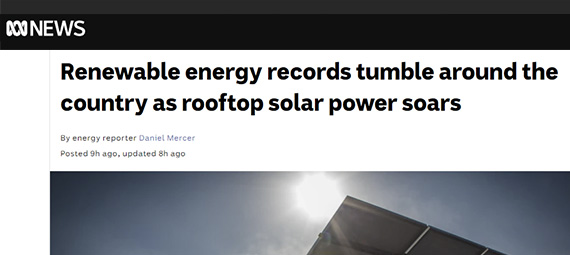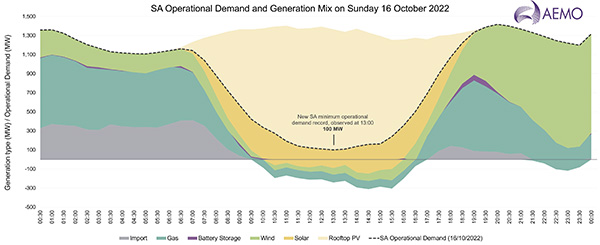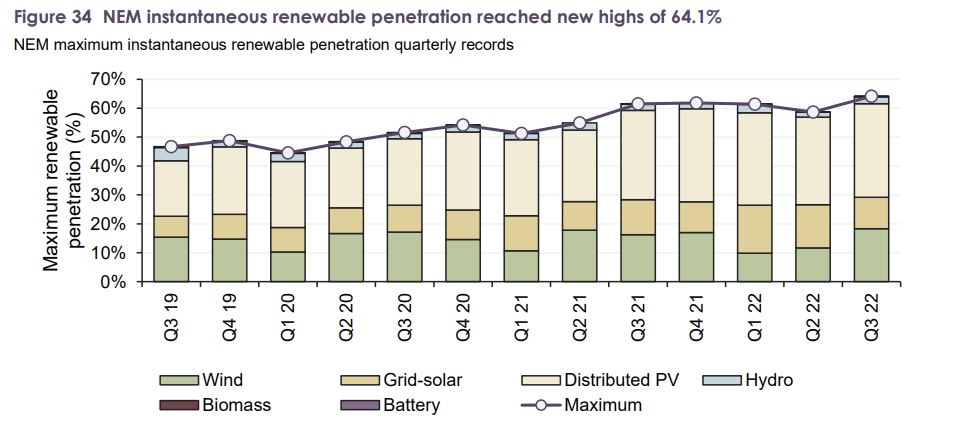by Jo Nova
With all the calm language of a paid ad agency, the ABC is breathless because an esoteric measure called “minimum operational demand” has hit a record or two. This glorious moment may have only lasted 30 minutes, and it isn’t actually a useful thing, but it’s a “record”.
In fact, “minimum operational demand” is a grid management headache, not a badge of honor. It’s the midday moment when solar panels all work — and it’s becoming such a problem that two states in Australia have said all new solar panels need “smart” controllers so that the guys in the central control rooms can turn the darn things off. That’s how good it is.

Renewable energy records tumble around the country as rooftop solar power soars
by ABC Energy Propaganda Reporter, Daniel Mercer
Soaring power production from households and businesses with rooftop solar panels has sent records tumbling across Australia as output from fossil fuels falls to all-time lows.
The record so-called minimum operational demand excludes the power generated by consumers with their own solar panels, which met 92 per cent of South Australia’s overall needs at one point on October 17.
The surge in power at midday forces the rest of the reliable generators to spin their wheels, running inefficiently, while they wait to be allowed back to do what they could have done all along without all the stopping and starting. It’s a miles per gallon kind of thing. Solar power makes the whole grid less efficient.
Here’s South Australia on October 16th setting a record in vanity-electricity:

The Duck Curve in South Australia. SA, Minimum operational demand. Click to enlarge. @AEMO,
The achievement is that the grid is so overdeveloped that it had twice as many generators as it needed at midday. Briefly, rooftop solar was making 92% of all the electricity the state could use.
Solar panels are the roadworks on the grid freeway that slows down the trucks and cars that are doing something useful. They provide poor quality electricity, which needs back up, frequency stabilizers, storage, long transmission lines, huge subsidies and large holes in the ground to store all the waste. Not to mention slave labor too. What’s not to like?
Having one “generator” supplying the whole state makes the grid more fragile — all it takes is one cloud bank to roll in, and a Gigawatt can disappear, just like that. A few years ago we came close to a crash on the East Coast because lightning hit the grid, and badly installed panels tripped out with minor frequency wobbles. As many as a third of the rooftop solar panels in South Australia bailed themselves out just when we needed them. Solar panels also cause surges at midday that can push the grid up to 253 volts (when it should be 240). The surges may be breaking appliances, and it costs more on your electricity bill too.
This AEMO graph below shows the exotic but mindless concept of “Instantaneous renewable penetration”. It creates the illusion that this concept is a long term meaningful attribute, when really this is just the peak half hour in a three month period, or 1 part in 4,000 of what we really need. This represents just the leading creeping edge of the fantasy. 99.99% of the time, the world doesn’t look like this.
The fine print:
28 Instantaneous renewable penetration is calculated using the NEM renewable generation share of total generation The measure is calculated on a half-hourly basis, because this is the granularity of estimated output data for distributed PV.
If they could have estimated the five minute peak of solar, they would have.
Other posts on solar
- Solar Owners worried Big Brother AEMO wants to turn off their panels at noon in emergencies
- SA: Still at risk of blackout, one third of solar PV “switching off” to save state, needs $1.5b interconnector bandaid to NSW
- Jeopardy: What happens when your single largest generator is uncontrolled and coordinated by clouds? Watch Western Australia
- White elephant solar panels: “force-feeding” high voltage, raising costs, breaking things, shutting themselves down
- Even AEMO head admits solar panels are a big “disrupter” in Australia – fears big players may abandon grid
- Solar subsidy death spiral: $2 billion in Australia, rising 50% pa as electricity prices rocket
- Bill shock debacle: Solar rooftop subsidies in Australia doubling, will cost $1.3 billion this year, $160 per household
- Some days one thousand MW of solar vanishes in Australia
- Blackout threat from rooftop solar panels in Western Australia
- Even in sunniest Queensland, solar can’t run without big subsidies — so big they have to be kept secret
- Solar overload — “Costs a fortune” as the super Duck Curve flood of electricity hits Australia
- NSW can’t keep coal plants, or aluminium smelters running, prices hit $14,000MW/hr
- 2 million expensive solar panels cut Australian total CO2 emissions by 1%
- Deadly: a quarter of all solar panels pose high or severe risk
REFERENCES
AEMO Reports, Q3 2022 Quarterly Energy Dynamics, PDF
Clean Energy Regulator 2022, Small-scale technology certificates
